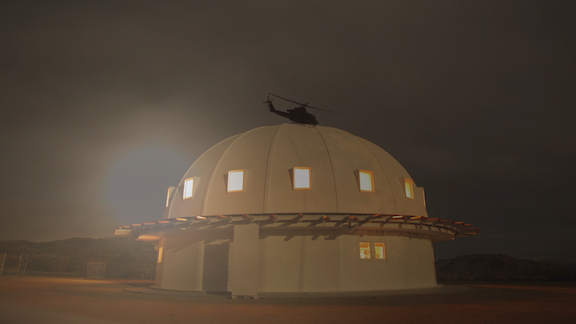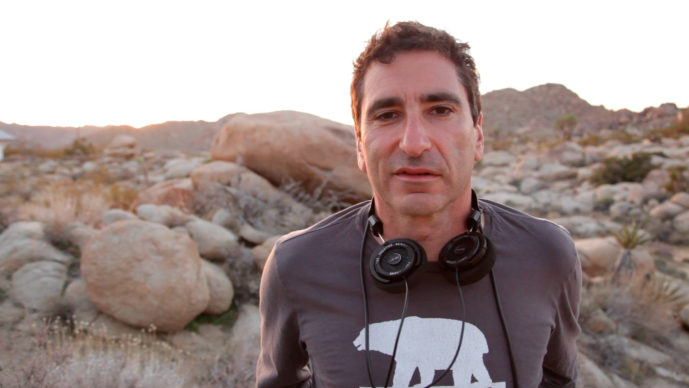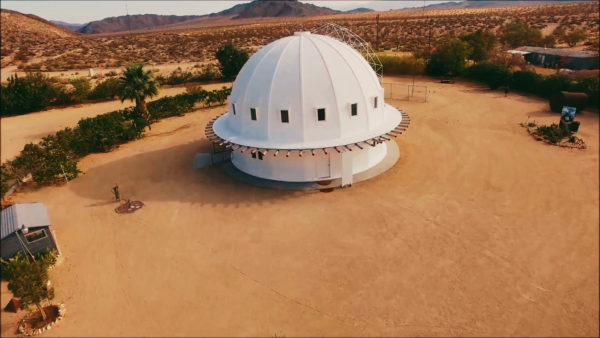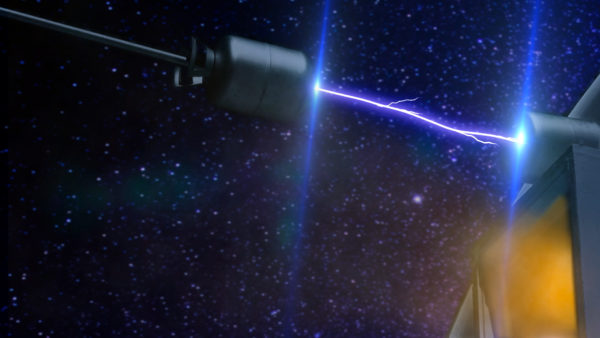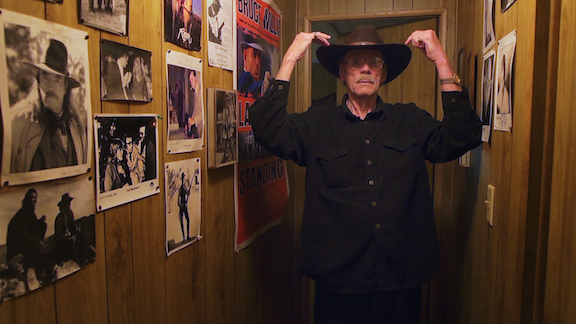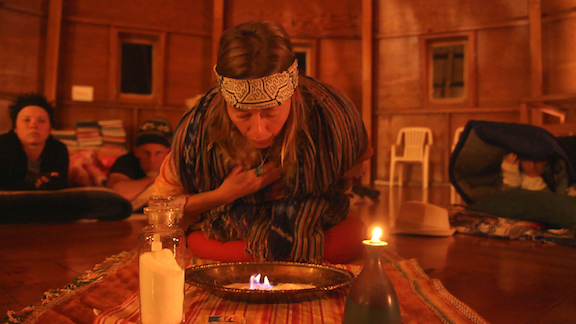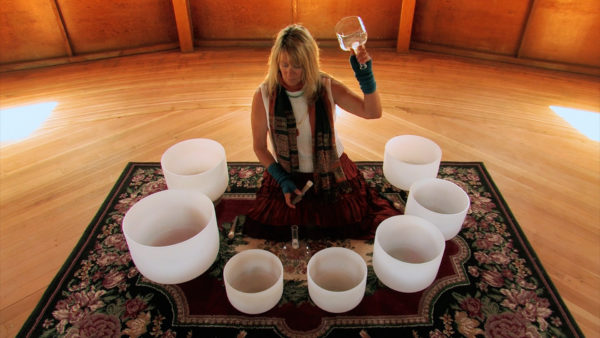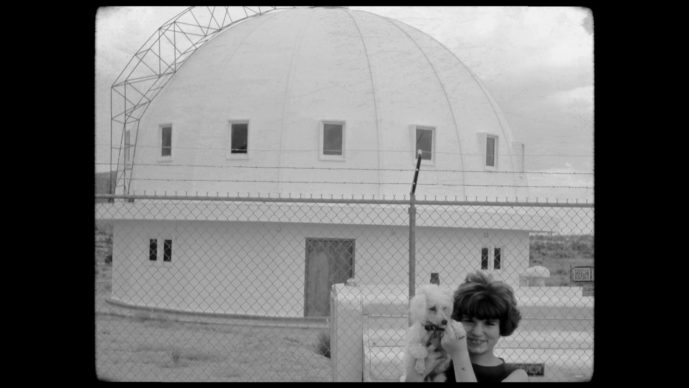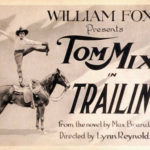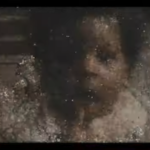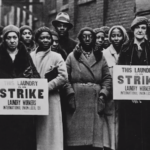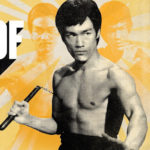Calling All Believers
WELCOME TO THE INTEGRATRON
Just a degree or two off the narrow path of rationally agreed reality lies a squirrelly track that heads out into deep space, into a la-la land where much is conceivable and pretty much anything is plausible.
One stop along that way is located in the Yucca Valley of California, 120 miles east of Los Angeles. There, on the desert floor, sits a curious construction called the Integratron. It’s right by the otherworldly Joshua Tree National Monument. A landscape harsher on humans, or more at home for Martians, or for that matter Venutians, is hard to imagine.
The Integratron, to which true believers have long assigned unlikely powers of rejuvenation and links to space aliens, is the key setting for Calling All Earthlings, a documentary film by Jonathan Berman (Commune, My Friend Paul, The Shvitz). It tells the curious tale of George Van Tassel and his encounters with a Venutian spaceman who told him how to build the Integratron. Van Tassell did as told, producing a life-prolonging device that is the size of and somewhat in the architectural style of a small deep-space observatory.
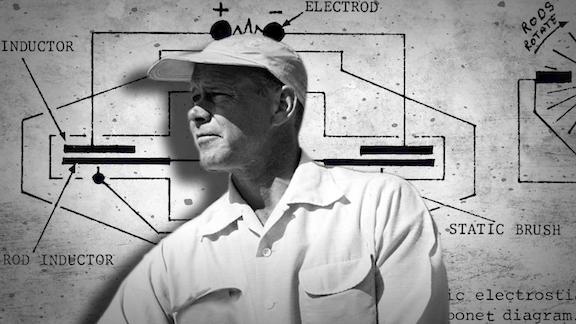
George Van Tassel moved to the desert and encountered a Venutian in 1954 who told him to build a time machine and life rejuvenator. From “Calling All Earthlings,” a 2018 feature documentary. All images courtesy of filmmaker. Copyright 2018 Carpe Stella Productions.
Nowadays the Integratron, never operational as a sort of giant Tesla coil, is an information center about Van Tassel and his theories. As Berman’s film shows, those theories stretch along a continuum from crackpot to cuckoo – which is to say, they flicker between indisputable and incontravertible, for the credulous.
At the film’s opening, voices not of aliens but of equally curious creatures — human denizens of the California desert — emanate from the severe scenery: “I saw a cat-like creature, coming down from the mountains, with glowing red eyes,” says a grizzled guitarist, sitting on a rock under a Stetson. “And then it disappeared into a red glowing light in the ground.”
“I was standing in the back of my apartment, one day,” begins another witness. “This was in 2006, and I saw a freakin’ UFO in the sky; it was the first one I ever seen. It was zigzaggin’ around the sky.”
George Van Tassel, mild-mannered aeronautical engineer by day, also became a contactee of aliens, one moonlit night. After an exemplary career at Douglas Aircraft and Lockheed, he moved to the California desert in the early 1950s at the encouragement of a miner he happened to meet. One night he awoke at 2 in the morning to find himself addressed by some sort of alien.
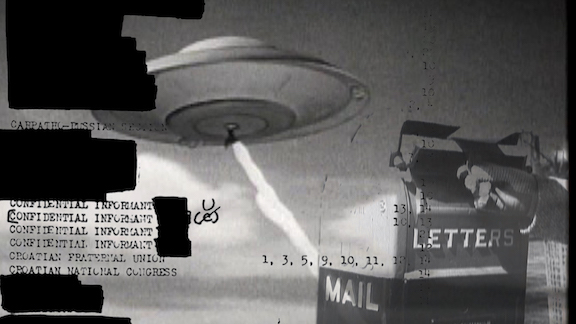
Could flying saucers be real? The FBI tracked Van Tassel, creator of the Integratron — the agency wanted to know, too.
“I didn’t see the ship land,” Van Tassell says, in worn footage from a television interview that Berman located (it’s from a far-away time when hosts smoked unabashedly on their sets). “One of my son-in-laws…saw it come down.”
Then?
“The man got off of the ship and approached me before I even knew there was a ship down. I asked him what he wanted and he said, ‘My name is Soganda and I’d be pleased to show you my craft.’”
Which Soganda did. Van Tassell, dressed in a dark suit and engineer’s idea of a stylish tie, flatly relates this with no trace of dissemblance, or even of surprise.
“Was this,” asks the tv-show host, “the guy that gave you the formula for the time machine” – the Integratron?
“That’s the man,” says Van Tassell.
“And what form did the formula take? Did he implant it in your mind by telepathy, or did he give you something written in English?”
“He spoke it to me verbally.”
What the alien said, having cannily come to Earth equipped with fluent English, provided Van Tassell with instructions for how to build the Integratron, which he eventually did.
What was the formula? It was, says Van Tassell, a veteran of helping Howard Hughes build some of the most complex machines humans had ever created, simply F=1/t, where “F” is frequency and “t” is time.
Loopy notions, great footage
The great charm of Calling All Earthlings is the archival footage that Berman and co-producer Danny Kuchuck were able to locate. It imparts an appropriate sense of otherworldliness to their account of Van Tassel’s unlikely progression from seemingly straightlaced aeronautical engineer to alien contactee and construction contractor.
Berman found the television-interview footage during an extensive search for supporting materials. That took him to well-known archival sources, such as the rich stores of material collected by Rick Prelinger, collector of a vast hoard of advertising, educational, industrial, and amateur films – “a hero,” says Berman.
Berman and Kuchuck also put out a general call to archivists — via, for example, the AMIA-L listserv of the Association of Moving Image Archivists.
It turned out that film footage relating to Van Tassel is hard to come by, but they did find useful clips in the far reaches of Google searches, in institutional archives (at the University of Washington, in the case of the television interview), and among such informal archives as piles upon piles of film canisters in an apartment in the Mission district of San Francisco — a teetering mountain of material that one night threatened to bury Berman alive.
“We took a deep dive on this film,” Berman says by phone. “We had the luxury of time to really think about it and let the clips that we found inform the filmmaking process.” That, he says, has made for a better film, and certainly ensured a more enjoyable filmmaking process than scrounging for footage to fit some preconceived narrative trajectory.
The George Van Tassel story illustrates how readily science can tumble into fantasy, or — as adherents to Van Tassel’s theories still attest, today — how chance or unforseeable events sometimes lead to detection of fantastical realms of perception and reality.
Van Tassel’s mind and eyes opened in the early 1950s after he moved his family to Giant Rock, a few miles from where his Integratron sits, today. He and his wife dug out a space under the enormous boulder, a monolith with significance in local Native American lore. The Van Tassels set up a cafe there; at the Come On Inn, Eva Van Tassel gained renown for her burgers and apple pie.
George Van Tassel built a small airport alongside the rock, and as he attracted a network of flyers he began to lead meditations, “channeling the space people, and bringing the messages through,” according to one modern-day curator of the site.
Again, archival material in Calling All Earthlings conveys the oddness of the undertaking. Viewers see the space dug out under the rock, and a cafe counter there, and the rocky surrounds, and hear Van Tassel, in a studied monotone, proclaim to any spacemen who happen to be listening: “We extend our greetings and love from the Council here at Blay’ah,” as he called the Rock.
In the same stilted diction, Van Tassel sought to ingratiate himself to attentive higher intelligences by explaining why so few earthlings were alert to their presence: “It is highly understandable how people confined to the surface of a planet can become very backwards in their acceptance of life.”
He signs off: “Until we register through to you there again… In love, I am Steppus.”
The “very backwards” people who always predominate when conversation turns to subjects like visitors from distant planets soon began to note Van Tassel’s activities, and question their sanity. Van Tassel heard the rumors that he was nuts, as we learn from an audio clip from a Rotary Club speech he gave in 1954. He had, he said, spent 20 years “climbing in and out of every aircraft ever built,” and “they don’t turn million-and-a-half-dollar aeroplanes over to screwballs.” (Van Tassel had worked for renowned eccentric gazillionaire industrialist and pilot Howard Hughes, he of “I’m not a paranoid deranged millionaire; goddamit, I’m a billionaire.”)
Van Tassel’s politics were suspected, too. Some fretting locals contacted the Federal Bureau of Investigation about “subversives” chanting “peace, love, harmony” in the vast desert expanses. The Feds, in a time of communist scares and general paranoia, became jumpy enough that they skulked into Yucca Valley to check for signs of Reds under beds, or under Giant Rock.
Convenient for developers of conspiracy theories about government interference with Steppus is that just before he was to complete work on his plans for the Integratron – these things always happen “just before” something or other – he was found dead in a motel room, of a massive heart attack.
Although he was surely knocked off his wobbly orbit by shadowy government agents – or his second wife, suggest his son and grandson — his demise was reported in Proceedings of the College of Universal Wisdom of Yucca Valley, CA, of which he was the director, as: “Induction March 12 1910, short circuit February 9 1978.”
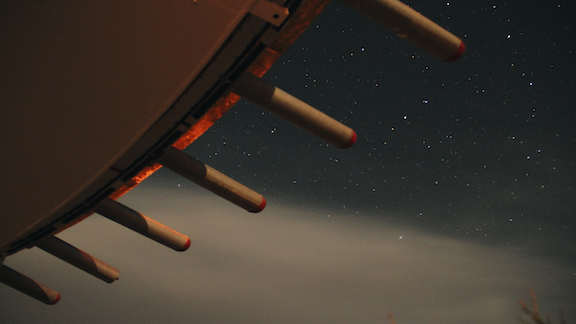
The Integratron dome in Landers, CA as depicted in “Calling All Earthlings.” The view from beneath parts of the machine that would have carried electrostatic current to the space within.
Van Tassel had attained the College’s directorship on the strength of, one, creating it, and two, organizing Interplanetary Spacecraft Conventions at Giant Rock from the mid-1950s up to the early 1970s. There, among claimed attendances of up to 10,000, discussion no doubt turned at times to his 1952 pamphlet I Rode a Flying Saucer: The Mystery of the Flying Saucers Revealed.
Says Danny Kuchuck, co-producer of Calling All Earthlings: “George was the first Aquarian mid-century guy,” an identity all the more to savor given that “he looked like he was out of a straight-edged educational film.”
Van Tassell was “the original channeler of the Ashtar Command,” according to a young dome-home builder who has landed in the area.
The Archival Hunt
Nowadays, when the never-quite-completed Integratron is not open to visitors interested in hearing about Van Tassel, it serves as a center for new-age activities — pleasant-enough folks lolling about as singing bowls resound and presumably sage-grass smoke and atomizing patchouli oil disperse.
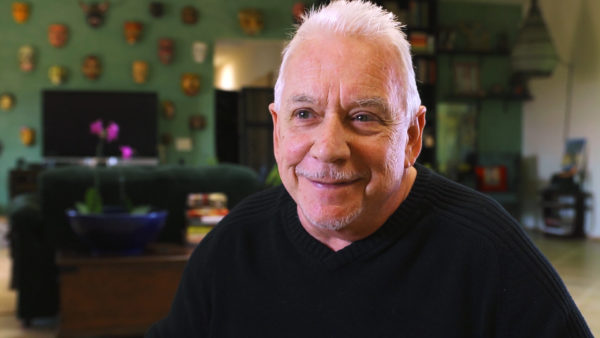
Singer/songwriter/artist Eric Burdon (The Animals, War) talks about the desert and UFO’s in the film.
As the film’s modern-day interviews show, various assortments of people have gravitated to the Integratron and its legends. Alongside nearby-marine-base conspiracy theorists, pro-defense retiree patriots, philosophizing tattoo artists, and glazed-eyed survivors of perhaps too much peyote and New Age hogwash are the now-deceased cowboy- and bikie-film actor Ted Markland and the rock musician Eric Burdon. They seem happy to have obliged the filmmakers, if only — in Burdon’s case — to affirm the eery beauty of the desiccated region that Van Tassel enlivened.
Also present to bear witness in the film are various figures from West Coast countercultural movements. Those include Art Kunkin, founder of the L.A. Free Press and more recently a Yucca Valley practitioner — he says — of alchemy. Also along are various academically oriented commentators who do or do not explain the Integratron’s place in California consciousness.
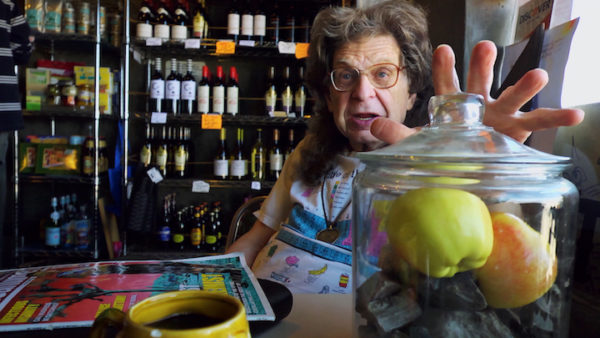
Art Kunkin, founder of the L.A. Press, explains in the film how his radioactive apples may restore youth.
Surely one ingredient in the rise of UFOlogy, Berman and Kuchuck say, is that the decades after World War II were a time of both optimism and fear in the United States. Atomic bombs had recently dropped, but nonetheless the sky, if it didn’t fall down, was the limit. Says Berman: “George Van Tassel came from the Howard Hughes mentality: Let’s throw a couple of millions bucks at this outlandish idea and fly some prototypes out in the desert and see if they work. They were optimistic that they could figure everything out. They thought, ‘We have just beaten fascism, so anything is possible.’”
Wealthy industrialists and suburban-garage tinkerers equally could make breakthroughs and build a better world with technology, or blow the globe up.
“The whole forward-with-science-thing,” says Berman, “was writ large out here with [Edwin] Hubble [who first proposed that the universe is expanding] and people like the Rosicrucians, who even advertised in Home Mechanics,” a high-circulation popular-science magazine.
Lightweight, portable movie cameras were in the mix: they permitted UFO witnesses to film spacecrafts, or believe they had. Archival audiovisual materials that would convey some of those aspects of the Van Tassel legend took a lot of dogged searching, Berman and Kuchuck report. But Berman is used to digging deep for source material. For his 2006 film, Commune, about a 1970s “intentional community” in California, he faced the prospect of telling the story with virtually no original film of the life of the commune. But then a Portapak video turned up: The Tribal Vision Archive, shot in 1968 by Loren Sears, a commune member who happened to have had one of the early consumer-market portable cameras. “That turned out to be key,” Berman says.
For his My Friend Paul (1999), he filmed in the penitentiary where his childhood pal, a bipolar bankrobber, was shut away. (Making that film, Berman says, he learned something that he bore in mind in making Calling All Earthlings: that when portraying people well outside the norms of everyday expectation, “sometimes there are five seconds too much of your main character and they become annoying, or you lose the magic.”)
Rich official and non-official archives
Berman has also been careful not to use too much footage from fiction films about alien contact, in telling his own film’s tale. He does include a clip from Ray Harryhausen’s Earth vs The Flying Saucers, an alien-invasion film from 1956, but that has a direct link to Van Tassel: Harryhausen went to Yucca Valley spacecraft conventions and was inspired by them in his filmmaking.
Images from those UFO Conventions are in Calling All Earthlings, too — early UFO enthusiasts, meeting in the middle of nowhere, captured in still-bright Kodachrome. That footage, as Danny Kuchuck says, looks like home movies, but provides telling historical context.
So, too, do images relating to other ultramundane theories and activities that had some link to Van Tassel, such as the teaching of Paramahansa Yogananda, the first Indian guru to spend the majority of his life in the United States, seen in outtakes from newsreel footage.
To create a “look” appropriate to his subject matter and its time, Berman makes use of such devices as maps on truckstop table mats of the time and “process plates” from the Prelinger Archive. The latter are constructed from background images over which live film action has been shot, such as cars heading out to the desert. Berman says that “in a past life” he categorized many process plates while working as an assistant editor at Producers Library Service, in Los Angeles, and was drawn to them again for Earthlings by the way they can oddly work “emotionally and intuitively” to advance a film’s narrative.
He and Kuchuck say they benefitted from assistance from a variety of private collectors. The late Stephen Parr and his Oddball Films “had some really interesting stuff, and he was a great resource,” says Kuchuck. “He would tell anyone who would listen that Jonathan and I were looking of footage of George van Tassel, or interesting footage of Howard Hughes.”
Also pitching in was Craig Baldwin, an avant-garde filmmaker who has amassed eclectic film. Says Berman: “He has stacks and stacks of cans in his basement in the Mission in San Francisco, where Other Cinema is, and his organization Artists’ Television Access. He is a UFO fan.”
It was at that apartment that Berman found himself sleeping one night among 15-foot stacks of film canisters in a city renowned for its tremors. Still, he says, “it’s exciting to literally be living amongst the footage.
“There are a lot of people out there who have hung onto stuff, and if you know how to reach them, they’re willing to share.”
To supplement the scant footage that has remained of George Van Tassel, Berman and Kuchuck turned to official sources such as freely available government archives of atom-bomb blasts in the California desert. In the decades following World War II, the U.S. government financed a lot of research, often in league with corporations run by visionaries like Howard Hughes, and makes it available through such outlets as the Defense Visual Image Distribution Service. “The government has some wild stuff,” says Berman, and exclaims: “And the military wants you to download it!”
Some of that material, viewers of Calling All Earthlings may conclude, presents a view of reality no more fantastical than that of George Van Tassel and his fellow travelers.
Of the kaleidoscope view of the aerospace engineer that he has provided, Berman says: “I like films that hang together by Scotch tape and magic and luck.”
Kind of the way conspiracy theories about aliens and suddenly dead contactees do.
—Peter Monaghan
Previous Post: Funds for Collections on Black Champions, Yu’Pik Life, and Censorship
Next Post: A Solution for All Data Storage Woes?

